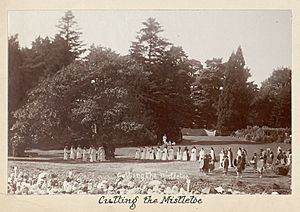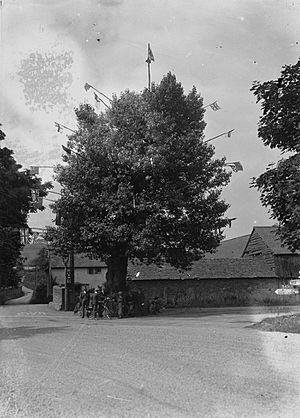Festive ecology facts for kids
Festive ecology is about understanding the special connections between plants, fungi, and animals and important cultural events. This includes things like festivals, parades, and other special occasions. It explores the meanings and traditions behind why certain living things are chosen for these celebrations.
Contents
Christmas Traditions
The plants we often see at Christmas – like holly, ivy, and mistletoe – have been important in older religions and cultures for a long time. Many early religions in Europe had midwinter festivals. These celebrated the sun's return after the shortest day of the year.
Around the 4th and 5th centuries, December 25th slowly became the date for Christmas in Europe. This helped to combine Christmas with the existing midwinter festivals. For example, the winter solstice (the shortest day) in the Northern Hemisphere was around December 17th. This was the start of the Roman festival called Saturnalia. This festival was a week of big parties, dancing, singing, and games. People decorated their homes with evergreens, and they gave bunches of holly as gifts to friends. When Saturnalia traditions were included in the Christian calendar, holly and other evergreens became part of Christmas too.
Holly's History
Holly leaves are spiky, but animals like to eat them! In medieval times in England and Wales, farmers used holly as winter food for their livestock. This was very common in areas like Cumbria and the Pennines. Hay and grains for animals often ran low in these hilly regions during winter. If animals didn't have enough food, farmers would have to kill them. This caused big problems for the economy in the years that followed. So, having fresh holly to feed the animals was extremely valuable.
Records show that people used holly for livestock from the late 1100s to the mid-1700s. After that, the practice mostly stopped. An old Welsh story called "The Dream of Rhonabwy" from the Mabinogion even mentions using holly for animals.
Ivy's Ancient Uses
The ancient Greeks and Romans used ivy in wreaths for religious events. They also used it for other fun celebrations. Ivy was strongly connected to Bacchus (also known as Dionysus), who was the Greco-Roman god of wine.
Since Roman times, ivy has been linked to wine and making wine. Sometimes, branches of evergreen ivy tied to a pole were used as a "sign of the bush." This sign showed that wine or alcohol was sold there. This is where the saying "Good wine needs no bush" comes from. It means that if something is really good, you don't need to advertise it much. Today, ivy is less common in British homes at Christmas compared to holly and mistletoe.
Mistletoe's Magic
Mistletoe is an evergreen plant famous for growing on trees like oaks. It's also well known for its link to the Druids. Pliny the Elder first wrote about this. He described the ceremonies of the Celtic Druids in Gaul in his book Naturalis Historia.
These Druids deeply respected the oak tree. They used oak leaves in their ceremonies. They believed anything growing on an oak tree was a gift from heaven. When mistletoe was rarely found growing on an oak, they would gather it with a special ceremony. A priest in white clothes would cut the mistletoe with a golden sickle. He would let it fall onto a white cloak. Then, two white bulls would be sacrificed.
According to Pliny, people believed that mistletoe in a drink could make animals that couldn't have babies fertile. They also thought it was a cure for all poisons. Many cultures, both in Europe and further away, believed mistletoe had special powers. The idea that mistletoe could heal everything and cure barrenness is thought to be very old.
The link between mistletoe and fertility still exists in Britain today. It's a tradition to kiss under bunches of mistletoe at Christmas. In the early 1800s, it was customary for each person who kissed under the mistletoe to remove one berry. Once all the berries were gone, the mistletoe's special power was believed to be gone too.
Yew Trees and Immortality
Yew trees are special because they constantly grow new stems. These new stems join with the older trunk, allowing the trees to live for a very long time. This mix of old, decaying wood and fresh, young shoots has led to the yew tree being linked to reincarnation (being reborn) and immortality (living forever).
Dressing the Arbor Tree in Aston-on-Clun
In Aston-on-Clun, a village in south Shropshire, England, there's a special custom. Every May 29th, people decorate the Arbor tree with flags on flagpoles. This custom is almost unique in Britain. Another similar tradition is "Bawming the Thorn" in Appleton Thorn, Cheshire. New flags are put on the Arbor tree and stay there all year.
The Arbor tree is a male black poplar tree. It grows next to a stream where four roads meet. Written records of the Arbor tree only go back to 1898. However, people say the tradition of dressing the tree started with a local wedding in 1786. The custom has changed and gained new meanings over time. Especially since 1955, when a special show was created. The show and the tree dressing celebrations are still changing. They adapt to the local community and the growing recognition of this unique tradition.
The current black poplar tree grew from a cutting taken from the old tree. The old tree was said to be at least 300 years old when it fell down in 1995. It had been regularly pollarded (cut back to encourage new growth). It's very unusual for a black poplar tree to be part of such important events or traditions. Usually, these traditions involve trees like pedunculate oaks, sessile oaks, common yews, or hawthorns.
The black poplar (Populus nigra var. betulifolia) is a rare native tree in Britain. Black poplars usually grow in wet, rich soils in river valleys and floodplains. They are mostly found south of a line from the River Mersey to the River Humber estuary. There are many in the Midlands from the Welsh Marches to East Anglia, and especially in the Vale of Aylesbury. A male version of the tree was planted a lot in the suburbs of Manchester in the late 1700s. It grew well in the polluted air and became known as the ‘Manchester poplar’.
Black poplars can grow up to 30 meters tall. Their bark is very distinct, with deep ridges and furrows. They also have large bumps or burrs. When they are fully grown, the tree forms a huge dome with massive branches spreading outwards. This wide, spreading shape is very different from the tall, thin Lombardy poplar (Populus nigra ‘Italica’). Surprisingly, the Lombardy poplar is a cultivated type of black poplar. It was brought to Essex from Turin in 1758 and planted widely because of its unusual shape. The black poplar is also a different species from the more common black Italian poplar (Populus x euramericana). This is a hybrid tree, a mix between the black poplar and the North American eastern cottonwood (Populus deltoides).
Black Poplar Reproduction and Life Cycle
Poplar trees are unusual because they have separate male and female trees. In Britain, male black poplars are much more common than female trees. Because of this, new seedlings are very rare. However, black poplars can regrow from the branches or trunk of fallen trees. These pieces can root into the soil and start growing again. Since they grow in river valleys and floodplains, these trees can be pulled up by floods. But they can then grow again in a new location.
Other Traditions
Other traditional customs on May 29th are usually linked to Royal Oak Day (Oak Apple Day). These include the old rights still practiced in Grovely Wood at Great Wishford, Wiltshire. Another is Garland King Day at Castleton in Derbyshire.
See also



